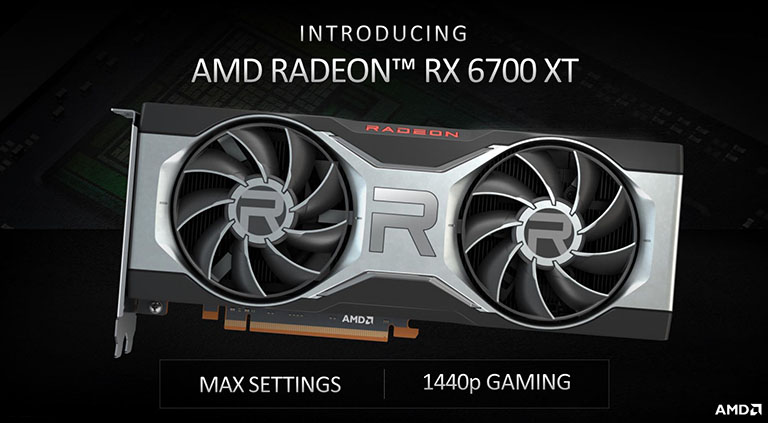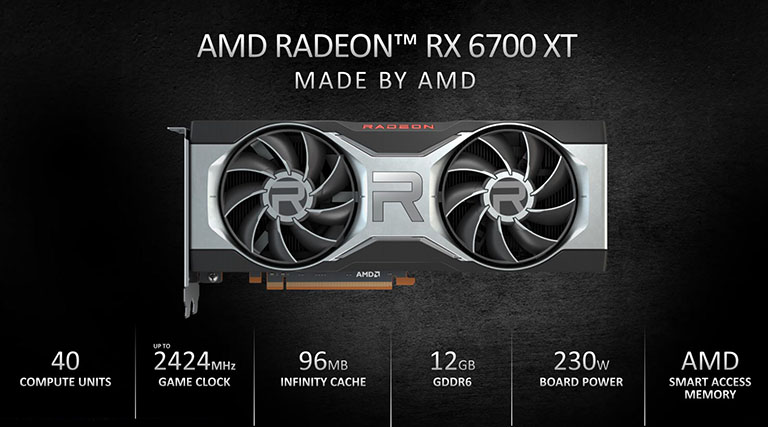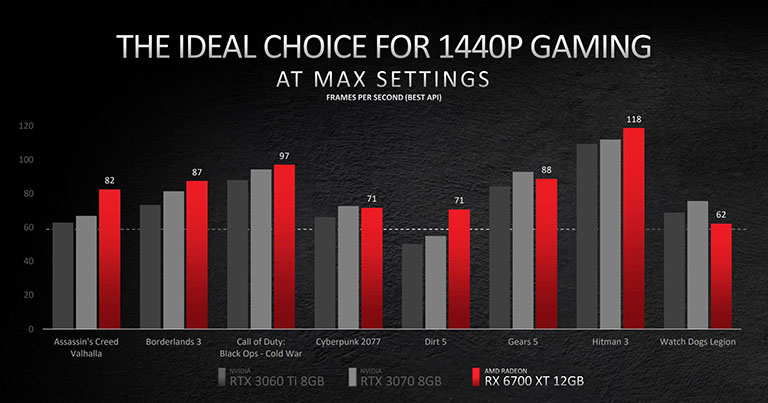AMD brought some high-end mojo back to the PC graphics card space when it launched the Radeon RX 6800 Series GPUs in November last year. Swiftly followed by the Radeon RX 6900 XT a month later, the three boards use what is colloquially known as the Big Navi die for excellent performance at QHD and UHD resolutions.
Costing $579, $649 and $999 for the RX 6800, RX 6800 XT and RX 6900 XT, respectively, putting the trio squarely in the premium firmament, AMD always planned to release cheaper, not-so-powerful Navi 2x cards destined to occupy the next rung down the pricing ladder and compete against rival Nvidia's larger RTX stack.
Fitting in neatly below RX 6800, the next GPU freshly cleaved off the Navi block is the wholly expected Radeon RX 6700 XT. Available from March 18 onwards in both Made By AMD (MBA) and partner-constructed models, pricing starts at $479.
As an ongoing sign of the times, AMD unveiled the Radeon RX 6700 XT during a stream broadcasted today. We've pieced together as many details as possible and presented the new GPU alongside some familiar graphics cards from AMD's performance stable.
From Navi 1x to Navi 2x |
||||||
|---|---|---|---|---|---|---|
Radeon RX 6900 XT |
Radeon RX 6800 XT |
Radeon RX 6800 |
Radeon RX 6700 XT |
Radeon RX 5700 XT |
Radeon RX 5700 |
|
| Launch date | December 2020 |
November 2020 |
November 2020 |
March 2021 |
July 2019 |
July 2019 |
| Codename | Navi 21 |
Navi 21 |
Navi 21 |
Navi 22 |
Navi 10 |
Navi 10 |
| Architecture | RDNA 2 |
RDNA 2 |
RDNA 2 |
RDNA 2 |
RDNA |
RDNA |
| Process (nm) | 7 |
7 |
7 |
7 |
7 |
7 |
| Transistors (bn) | 26.8 |
26.8 |
26.8 |
?? |
10.3 |
10.3 |
| Die Size (mm²) | 519 |
519 |
519 |
?? (335) |
251 |
251 |
| Full Implementation of Die | Yes |
No |
No |
?? |
Yes |
No |
| Hardware Raytracing | Yes |
Yes |
Yes |
Yes |
No |
No |
| Infinity Cache (MB) | 128 |
128 |
128 |
96 |
No |
No |
| Compute Units | 80 |
72 |
60 |
40 |
40 |
36 |
| Processors | 5,120 |
4,608 |
3,840 |
2,560 |
2,560 |
2,304 |
| Texture Units | 320 |
288 |
240 |
160 |
160 |
144 |
| ROP Units | 128 |
128 |
96 |
?? |
64 |
64 |
| Boost Clock (MHz) | 2,250 |
2,250 |
2,105 |
?? (2,500+) |
1,905 |
1,725 |
| Game Clock (MHz) | 2,015 |
2,015 |
1,815 |
2,424 |
1,755 |
1,625 |
| Peak GFLOPS (SP) | 23,040 |
20,736 |
16,166 |
?? (13,000) |
9,750 |
7,950 |
| Memory Type | GDDR6 |
GDDR6 |
GDDR6 |
GDDR6 |
GDDR6 |
GDDR6 |
| Memory Size (GB) | 16 |
16 |
16 |
12 |
8 |
8 |
| Memory Clock (MHz) | 16,000 |
16,000 |
16,000 |
16,000 |
14,000 |
14,000 |
| Memory Bus (bits) | 256 |
256 |
256 |
?? (192) |
256 |
256 |
| Max Bandwidth (GB/s) | 512 |
512 |
512 |
?? (384) |
448 |
448 |
| PCIe Support | Gen 4 |
Gen 4 |
Gen 4 |
Gen 4 |
Gen 4 |
Gen 4 |
| Power Connectors | 8+8 |
8+8 |
8+8 |
8+6 |
6+8 |
6+8 |
| TDP (watts) | 300 |
300 |
250 |
230 |
225 |
180 |
| GFLOPS per watt | 76.8 |
69.1 |
64.66 |
?? (56.5) |
43.3 |
44.2 |
| Launch MSRP | $999 |
$649 |
$579 |
$479 |
$399 |
$349 |
Our guesses are in brackets
Radeon RX 6700 XT Specification Analysis
All slides and numbers provided by AMD
AMD's presentation was deliberately light on the technical detail that will be divulged between now and the March 18 official launch date. We know this new GPU uses the same RDNA2 architecture present on the trio of higher-performing boards. We also now know RX 6700 XT is outfitted with 40 CUs, 96MB of Infinity Cache, 12GB of GDDR6 memory, a 2,424MHz Game Clock and total board power of 230W.
Employing the knowledge of how the RDNA2 architecture is built and using these scant few numbers we can extrapolate more detail. Being a 40-CU part means RX 6700 XT is very likely to use a smaller, distinct die than present elsewhere in the RX 6000 Series stack. Known in the business as Navi 22, this GPU is likely to feature 2,560 processors, whereas the next model up, RX 6800, has 3,840. Ensuring RX 6700 XT is no vastly poorer cousin, AMD's decision to ramp up the Game Clock to an impressive 2,424MHz goes some way into pushing up shading performance. We reckon this chip is likely to push around 13TFLOPs once the as-yet-unknown Boost Clock is taken into account.
Elsewhere, the 12GB GDDR6 memory is important as it indirectly infers AMD is using a 192-bit memory bus, instead of the 16GB/256-bit present on the established cards. Even though this GPU features bandwidth-saving goodness of Infinity Cache, AMD remains a champion of larger VRAM framebuffers - rival GeForce RTX 3070 and RTX 3060 Ti make do with just 8GB. The 230W board power feels high for a fourth-rung card but can likely be explained by AMD having such high core frequencies in place.
AMD's implementation choices translate to a card that is primed for excellent performance at QHD with all the eye candy bells and whistles turned on. In fact, AMD took the opportunity of comparing the RX 6700 XT's performance against rival RTX 3070 and RTX 3060 Ti across eight titles benchmarked at QHD using the best API for each card.
If AMD's numbers are to be believed, the RX 6700 XT is generally faster than the RTX 3060 Ti and more than a performance match for the RTX 3070. Note that AMD is benchmarking with framerate-enhancing Smart Access Memory (SAM) turned on... so it's not a perfectly apples-to-apples comparison. AMD's not shy at extolling the virtues of the larger memory footprint, either, drawing attention to the advantages of 12GB vs. 8GB in four titles run at QHD maximum settings.
We'll have the full review on March 17, but the key takeaways from today's presentation is that AMD feels confident in pitching the Radeon RX 6700 XT against established performant GPUs from Nvidia's latest RTX portfolio. Questions certainly remain: how well does RX 6700 XT do once ray tracing is turned on? Is there scope for further overclocking given the already-high frequencies?
Circling back to a familiar but painful theme over the past six months, suggested pricing verges on pointless when set against the backdrop of severe stock scarcity. Equally applicable to Nvidia and AMD, only a handful of units for each model have been available at launch, much to enthusiasts' understandable chagrin.
AMD had the following statement regarding stock and availability: 'we hear, and understand, the frustration from gamers right now due to the unexpectedly strong global demand for graphics cards. With the AMD Radeon RX 6700 XT launch, we are on track to have significantly more GPUs available for sale at launch. We continue to take additional steps to address the demand we see from the community. We are also refreshing stock of both AMD Radeon RX 6000 Series graphics cards and AMD Ryzen 5000 Series processors on AMD.com on a weekly basis, giving gamers and enthusiasts a direct option to purchase the latest Ryzen CPUs and Radeon GPUs at the suggested etail and retail price.'
MBA boards will be listed on AMD.com and a slew of partner models at your favourite etailer on March 18.
What do you think? Does Radeon RX 6700 XT 12GB do enough at the purported price point? We'd love to hear your thoughts in the forums.

















